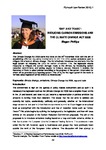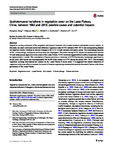Living with a changing climate: Holocene climate variability and socio-evolutionary trajectories, central Turkey
| dc.contributor.supervisor | Roberts, Neil | |
| dc.contributor.author | Allcock, Samantha Lee | |
| dc.contributor.other | School of Geography, Earth and Environmental Sciences | en_US |
| dc.date.accessioned | 2013-08-05T10:24:48Z | |
| dc.date.available | 2013-08-05T10:24:48Z | |
| dc.date.issued | 2013 | |
| dc.date.issued | 2013 | |
| dc.identifier | 10258638 | en_US |
| dc.identifier.uri | http://hdl.handle.net/10026.1/1591 | |
| dc.description.abstract |
Collaborative studies between Quaternary scientists and archaeologists increasingly provide new and informative discussions about the nature and timing of cultural change and links with variation in the natural world (particularly climate). In the Eastern Mediterranean region, connecting the human past with palaeoclimate is an important research theme but the complex interactions between them are still poorly understood and past climate records have often been collected from regions distant from the human record. The thesis aims to derive a record of past climatic and environmental changes from lake sediment cores and synthesise this with archaeological data in order to reconstruct human-climate interactions at the regional scale. Annually laminated sediment data collected from Nar Gölϋ crater-lake and archaeological archives from the same region, Cappadocia (Turkey) allow problems of chronological uncertainty between records of the human past and palaeoclimatic archives, and spatially variable datasets to be addressed. New sediment cores collected from Nar Lake in 2010 cover the last ~14000 years based on varve counting and climate-stratigraphic correlation. The changing chemical composition of these sediments has been obtained using high-resolution Itrax XRF core scanning, mainly at 200μm resolution over 21.6m. Temporal differences in Ca and Sr are interpreted as a record of regional moisture levels, while Ti and Fe are elemental proxies that detail changes in catchment in-wash. These and other sedimentary data (e.g. total carbon analysis) document lake evolution from a predominately stable and moist early Holocene climate dominated by high authigenic Ca precipitation to a drier and less stable IV late Holocene dominated by increased authigenic Sr and Mg (and higher lake salinity levels). The most arid climatic conditions occurred during Bronze and early Iron Age times, but frequent and intense centennial-scale climatic shifts between wet and dry are also evidenced during the last 2600 years from Ca/Sr data. Peaks in Fe and Ti, along with Si, K and Rb indicate two distinct phases of increased sediment influx into Nar Lake, namely ~9200 to ~8000 yr. BP (ceramic Neolithic) and again – more importantly – during the last 2600 years (Iron Age and later). These appear to be related primarily to increased human impact on vegetation and soils in the lake-catchment, but volcanic activity and intense rainfall events and/or water deficits may also have played a role. To determine the degree to which climatic variability and cultural change are interlinked, the geochemical record from Nar Lake is correlated against long-term settlement histories which have been derived from systematic archaeological site survey and excavation data from Cappadocia. One of the key outcomes of the project is an examination of periods of climatic stability and instability which are identified by amplitudinal changes from the mean state using correlation of coefficient statistics on the Nar Lake geochemical record. This information about the predictability of climate has been coupled to data in settlement density and location within the resiliency model framework of Holling and Gunderson (2002). Together these data suggest that a series of four long-term adaptive cycles (Neolithic, Chalcolithic-Bronze Age, Iron Age-Classical, Byzantine-Ottoman) characterise the dynamic inter-play between people, climate and their environment. In each adaptive cycle, environmental change contributed (both positively and negatively) to community resilience, although at no point during the Holocene is climatic variability seen as the sole driver of societal change. There were times such as the post-Roman Dark Age (1300 to 1100 yr. B.P.) when increased climatic variability and environmental degradation may have heightened social vulnerability. | en_US |
| dc.description.sponsorship | Studentship awarded by SoGEES, Plymouth University | en_US |
| dc.language.iso | en | en_US |
| dc.publisher | University of Plymouth | en_US |
| dc.subject | Holocene climate change | |
| dc.subject | Environmental and climatic variability | |
| dc.subject | Cappadocia (central, Turkey) | |
| dc.subject | Settlement change, resilience and adaptability | |
| dc.subject | Climate Change | |
| dc.subject | Human-climate interactions | en_US |
| dc.title | Living with a changing climate: Holocene climate variability and socio-evolutionary trajectories, central Turkey | en_US |
| dc.type | Thesis | |
| plymouth.version | Full version | en_US |
| dc.identifier.doi | http://dx.doi.org/10.24382/3536 |
Files in this item
This item appears in the following Collection(s)
-
01 Research Theses Main Collection
Research Theses Main




